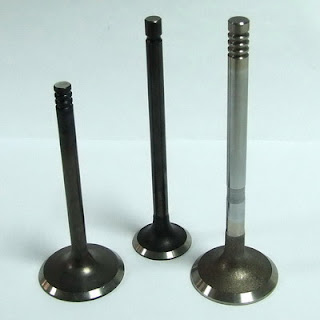 |
| Add caption |
Rocker operation of valves presents certain problems;
a tappet clearance must be allowed to suit thermal expansion of the valve stem. Insufficient clearance may result in the valve not fully closing whilst excessive clearance can effect timing and the period the valve is open. Hammering will also take place at the tappet face. (The use of self adjusting hydraulic tappets went some way to alleviating these problems)
A side thrust is imparted to the valve stem when the valve opens. Thus causing wear at the stem bushing and subsequent leakage
wear takes place at the pushrod and valve contact face, additionally the rocker bearings require constant lubrication.
To avoid these problems hydraulic valve actuation is used there is no tappet and no tappet clearance to set. Thermal expansion is accounted for by allowing the oil to escape at a relief valve on the pump unit. Oil loss is made up at the pump unit from the cam lube oil supply system. The opening face is always axial. Note: The hydraulic pipe must be sheathed to avoid the risk of fire in the event of pipe failure.
Cross section through modern exhaust valve
With modern fuels, vanadium and other deposits can build up on valve faces leading to damage. These deposits can be hammered into the seating faces. If the valve is rotated and reseats in a different place then the same dmage does not occur. Rotating the valve also prevents localised overheating due to a faulty atomiser.. If the valve is set spinning and is still rotating as it reseats a light grinding action takes place. This removes deposits and ensures a good seal. Such rotation is induced by spinners on the valve stem upon which the escaping exhaust gas acts.. To allow for this effect the frictional effect of the springs and valve/cover must be removed. The removal of springs means that a closing force by some other means is required. Air springing can be used. This consists of a piston fitted to the valve stem below the hydraulic unit. As the valve opens air below the piston is compressed and this compression provides the upward force of closing the valve. The space above the piston is vented to atmosphere and the pressure below the piston maintained at 5 bar from an air supply via a non-return valve.
An additional advantage with this system is that when the engine is stopped the valves will all close after a short delay. This prevents the flow of cool scavenged air through units which with a rocker system would otherwise be open.Preventing this allows all cylinder to be equally warm and stops the rotation of the turboblower which can occur.
Springs
Springs of sufficient force must be provided in order to ensure that the valve closes when the tappet force is removed. Once the valve is closed, the pressure in the cylinder will increase the sealing force on the valve seat.
Springs have natural frequencies and if the engine operating frequency is close to the natural frequency of the spring then vibration will take place and valve bounce will occur. Springs also twist when they are compressed and this causes wear at the landing faces. To avoid problems, double springs may be fitted one inside the other in parallel. These springs must be of different size and so have different natural frequencies. Valve bounce due to spring vibration is thus avoided.
The springs are wound in different directions to prevent twist and also to prevent one coil entering the other in the event of breakage, thereby locking it up.
Long springs tend to bow out when they are compressed and this increases the risk of stress failure. A solution is to have two springs in series, one above the other and separated by a centre disc which is located via a pivoted arm arrangement so that only vertical movement is allowed. Series /parallel arrangements are available.
Modern engines use pneumatic springs. Thisi both eliminates the problems of valve bounce , spring brakage and also the need for rotor caps. As the valve is free floating spinner vanes fitted on the spindle allow the valve to be rotated by the flow of exhaust gas.
Rotocap
The rotocap is a mechanical device which produces valve rotation by a small amount as the valve opens. The valve rotation is about 8o when the unit is in good condition.
Rotation to a new position avoids deposits from being hammered into the seat and repositions the valve thus preventing local overheating. Frictional contact is provided through the springs to the valve cover via the belleville washer which contacts at point A and C. As the tappet force increases to open the valve, the belleville washer is collapsed thus removing that frictional contact. Further increase in tappet force acts on the spring loaded ball bearings and the ramped slots tend to slide over the ball bearings. These slots are in the valve cover which is connected to the stem thus as the cover moves it rotates the valve.
As the tappet force is removed when the valve closes the belleville washer restores frictional contact and prevents further rotation. Springs return the ball bearings to their original position ready for the next stroke.
Valve closing Valve opening
rotor cap in unloaded position rotor cap in loaded position
Action of rotor cap
This comment has been removed by the author.
ReplyDelete